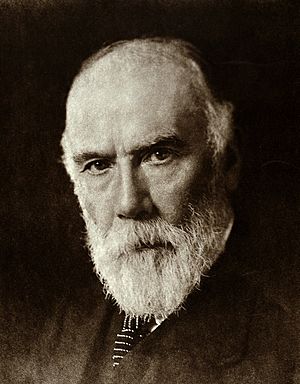James Mackenzie (cardiologist) facts for kids
Quick facts for kids
Sir James Mackenzie
|
|
|---|---|
 |
|
| Born | 12 April 1853 Scone, Scotland
|
| Died | 26 January 1925 (aged 71) London, England
|
| Nationality | Scottish |
| Scientific career | |
| Fields | Cardiology, General Practice |
Sir James Mackenzie FRS FRCP (12 April 1853 – 26 January 1925) was a Scottish cardiologist who was a pioneer in the study of cardiac arrhythmias. Due to his work in the cardiac field he is known as a research giant in primary care, and was knighted by King George V in 1915.
Biography
James Mackenzie was born at Pictonhill in Scone, where his father was a farmer. He left school at Perth Academy aged 14 and was apprenticed to a chemist. In 1873 he was offered a partnership in the chemist's firm but turned it down in order to study medicine. After private tuition in Latin he passed his entrance examination for the University of Edinburgh in October 1874 and qualified as a doctor in 1878. After completing his residency in Edinburgh, Mackenzie became a general practitioner in borough of Burnley in Lancashire, England where he continued to practice medicine for more than a quarter of a century. While he was engaged in a busy practice, he made many original observations, completed his MD degree on hemi-paraplegia spinalis (awarded by the University of Edinburgh in 1882) and had many scientific papers published. During Mackenzie's initial research carried out in the Burnley general practice he corresponded and discussed his findings with other well known pioneers Wenkebach and Osler. Mackenzie's ongoing investigations led him to leave general practice and become a specialist cardiologist. He expressed prophetic concerns about the specialisation of medicine including cardiology stating: 'I fear the day may come when a heart specialist will no longer be a physician looking at the body as a whole, but one with more and more complicated instruments working in a narrow and restricted area of the body – that was never my idea'.
In his early studies Mackenzie used Riva-Rocci's sphygmograph to graphically record the pulse. Later Mackenzie devised a "polygraph," that allowed him to make simultaneous records of the arterial and venous pulses. He used this to evaluate the condition of the heart and to measure the AV interval. In 1890 he discovered premature ventricular contractions and use of the polygraph enabled Mackenzie to make original distinctions between harmless and dangerous types of pulse irregularities (arrhythmias). Mackenzie also demonstrated the efficacy of Digitalis in the treatment of arrhythmias and made important contributions to the study of the energetics of the heart muscle.
In November 1907 Mackenzie left Burnley for London and set up as a consulting physician where his reputation grew rapidly. In 1915 he was elected a Fellow of the Royal Society and was knighted. Three years later he founded the influential Mackenzie Institute of Clinical Research in St Andrews, which involved local General Practitioners in detailed long-term recording of patients' symptoms and illnesses.
Ironically Mackenzie himself suffered from an irregular heart beat, as a result of ischemic heart disease. He had his first heart attack in 1901, and recorded in himself the atrial fibrillation that accompanied this episode. By 1907 Mackenzie experienced frequent episodes of angina pectoris which he mentioned to Sir Thomas Lewis and in 1908 he had a severe episode of cardiac pain, probably due to a myocardial infarction. His angina continued after 1908 and became progressively worse until in January 1925 he had a prolonged and severe attack of angina and died at around 4am on 26 January 1925. Before his death Mackenzie had asked that his friend John Parkinson perform an autopsy after his death. This was done and showed extensive coronary artery disease and evidence of recent and old myocardial infarction. A description of the case was published in the British Heart Journal in 1939. Two early polygraphs and a bronze bust of Mackenzie are in the collection of the Tayside Medical History Museum.
Other sources



